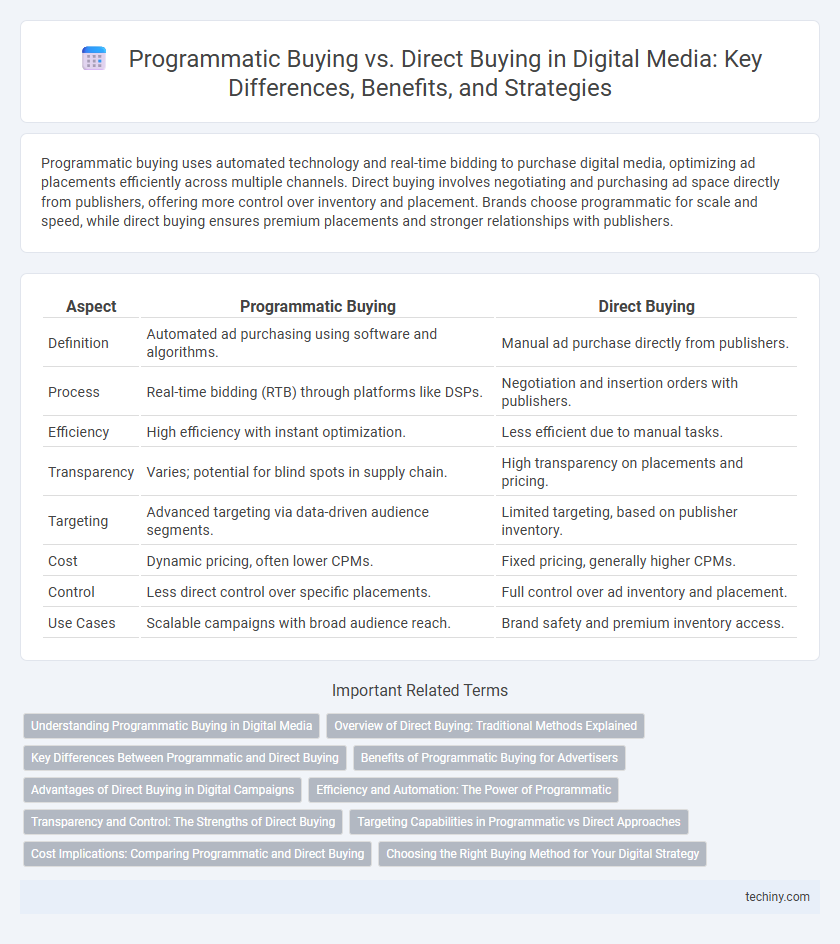Programmatic buying uses automated technology and real-time bidding to purchase digital media, optimizing ad placements efficiently across multiple channels. Direct buying involves negotiating and purchasing ad space directly from publishers, offering more control over inventory and placement. Brands choose programmatic for scale and speed, while direct buying ensures premium placements and stronger relationships with publishers.
Table of Comparison
| Aspect | Programmatic Buying | Direct Buying |
|---|---|---|
| Definition | Automated ad purchasing using software and algorithms. | Manual ad purchase directly from publishers. |
| Process | Real-time bidding (RTB) through platforms like DSPs. | Negotiation and insertion orders with publishers. |
| Efficiency | High efficiency with instant optimization. | Less efficient due to manual tasks. |
| Transparency | Varies; potential for blind spots in supply chain. | High transparency on placements and pricing. |
| Targeting | Advanced targeting via data-driven audience segments. | Limited targeting, based on publisher inventory. |
| Cost | Dynamic pricing, often lower CPMs. | Fixed pricing, generally higher CPMs. |
| Control | Less direct control over specific placements. | Full control over ad inventory and placement. |
| Use Cases | Scalable campaigns with broad audience reach. | Brand safety and premium inventory access. |
Understanding Programmatic Buying in Digital Media
Programmatic buying in digital media leverages automated technology and data-driven algorithms to purchase ad inventory in real-time, optimizing targeting and efficiency. This method contrasts with direct buying, where advertisers negotiate fixed placements manually, often resulting in higher costs and less flexibility. Programmatic buying enhances campaign performance by enabling precise audience segmentation, dynamic bidding, and measurable outcomes across multiple digital platforms.
Overview of Direct Buying: Traditional Methods Explained
Direct buying in digital media involves advertisers purchasing ad inventory directly from publishers through established relationships, ensuring premium placements and greater control over brand safety. This traditional method relies on negotiated agreements, fixed pricing, and guaranteed ad delivery, offering transparency and exclusivity often absent in programmatic buying. Direct buying suits campaigns requiring specific audience targeting and high-quality environments without the complexity of automated bidding systems.
Key Differences Between Programmatic and Direct Buying
Programmatic buying automates the ad purchasing process through real-time bidding on digital platforms, enabling precise targeting and data-driven optimization, while direct buying involves manual negotiation and securing inventory directly from publishers for guaranteed placements. Programmatic methods leverage algorithms and audience data to maximize reach and efficiency, contrasting with direct buying's reliance on established publisher relationships and fixed pricing. Key differences include transparency, flexibility, access to inventory, and campaign scalability in programmatic versus fixed inventory control and premium placement in direct buying.
Benefits of Programmatic Buying for Advertisers
Programmatic buying offers advertisers enhanced targeting capabilities by using real-time data and machine learning algorithms to reach specific audiences with precision across multiple platforms. It improves efficiency by automating the ad purchasing process, reducing manual effort and allowing for faster campaign adjustments based on performance metrics. Cost-effectiveness is achieved through dynamic bidding strategies that optimize ad spend and maximize ROI compared to traditional direct buying methods.
Advantages of Direct Buying in Digital Campaigns
Direct buying in digital campaigns offers precise audience targeting and enhanced control over ad placements, ensuring brand safety and consistent messaging. It enables advertisers to build stronger relationships with publishers, often resulting in premium inventory access and negotiated rates. This approach minimizes ad fraud and latency issues, leading to higher campaign effectiveness and return on investment.
Efficiency and Automation: The Power of Programmatic
Programmatic buying harnesses advanced algorithms and machine learning to automate media purchases, significantly enhancing efficiency by targeting precise audience segments in real-time. Unlike direct buying, which relies on manual negotiations and fixed inventory, programmatic optimizes budget allocation dynamically, reducing wasted spend and improving campaign performance metrics such as click-through rates and conversion rates. The automation inherent in programmatic buying accelerates campaign execution and allows continuous optimization, driving higher ROI for digital media marketers.
Transparency and Control: The Strengths of Direct Buying
Direct buying offers unparalleled transparency by providing advertisers with full visibility into where their ads are placed and how budgets are allocated, ensuring precise control over campaign execution. This approach enables advertisers to negotiate terms directly with publishers, reducing the risk of fraud and ensuring brand safety. Enhanced control in direct buying allows for tailored strategies and optimizes ad performance by maintaining close relationships with media owners.
Targeting Capabilities in Programmatic vs Direct Approaches
Programmatic buying leverages advanced data analytics and real-time bidding to enable highly precise audience targeting across multiple channels, utilizing parameters such as demographics, behaviors, and geolocation. Direct buying typically involves negotiated deals with specific publishers, offering limited targeting flexibility but ensuring premium placements and brand safety. The enhanced targeting capabilities of programmatic buying drive more efficient ad spend and improved campaign performance compared to traditional direct approaches.
Cost Implications: Comparing Programmatic and Direct Buying
Programmatic buying leverages automated technology and real-time bidding, often leading to lower media costs by optimizing ad placements and reducing the need for manual negotiations. Direct buying involves fixed pricing and guaranteed inventory from publishers, which can result in higher upfront costs but offers greater transparency and control over ad placements. Evaluating ROI requires assessing cost efficiency against campaign goals, where programmatic may reduce CPM rates while direct buying ensures premium audience targeting.
Choosing the Right Buying Method for Your Digital Strategy
Programmatic buying offers real-time bidding and precise audience targeting through automated platforms, enhancing efficiency and scalability for digital media campaigns. Direct buying provides guaranteed inventory and premium placements by negotiating ad space directly with publishers, ensuring brand safety and consistent visibility. Evaluating campaign goals, budget flexibility, and desired control helps determine whether programmatic automation or direct publisher relationships best fit your digital strategy.
Programmatic Buying vs Direct Buying Infographic

 techiny.com
techiny.com